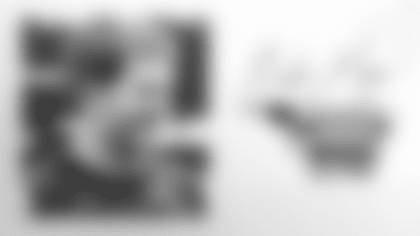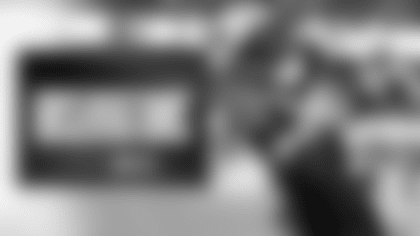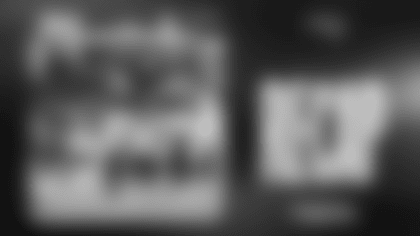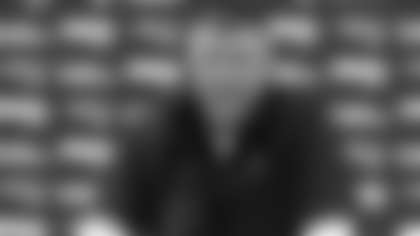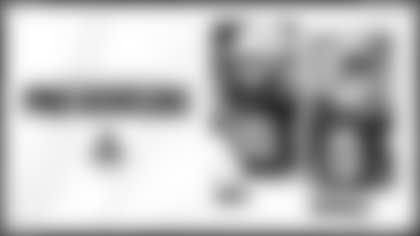The Patriots quarterback situation has taken a few unexpected turns with two games over the last six days.
Following last Monday night's unorthodox quarterback platoon, the Patriots returned to normalcy by sticking with starter Mac Jones for the entirety of a 22-17 win against the Jets in the Meadowlands. Although a divisional road win is always nice, there are still more questions than answers about Jones and the offense moving forward. And in the long term, there will be continued debate about if Mac is a franchise quarterback.
To use an old football trope, is Jones a truck or a trailer? A truck can tow or carry a team to wins, while a trailer is just along for the ride.
At this stage, 22 starts into Mac's career, it's still TBD. We have learned that, like most second-year quarterbacks, Jones is not impervious to the situation around him. He's far from the first young QB to struggle with handling pressure and turnovers, especially in these conditions. Just ask Peyton Manning, who had a league-high 28 interceptions in his rookie season until the Colts settled things down for him offensively, or any of Mac's classmates in the first round of the 2021 draft (see: Wilson, Zach).
The issues Jones is having adapting to a new offensive play-caller and shaky offensive line play are not unique, unexpected, or new. They go back to training camp when both things were factors in an uneven summer. But that doesn't excuse him for some of the bad habits that he has developed.
Starting with the positives, which were more prevalent after review than it felt live, unofficial offensive play-caller Matt Patricia and Jones finally found a passing script we can get behind.
Due in part to the Jets defense, Jones set a season-lows in average target depth (4.7 yards) and pass attempts over 20 yards (three). The Pats QB was under center 19 times, attempted eight play-action passes, and ran 13 run-pass options on 44 drop-backs.
Whether it was the coaches or the QB driving the shift, the play-calling got back to what Mac does best, ditching the vertical passing game for quick short and intermediate concepts and routes at the sticks on third downs.
For example, the Jets defense mixed in a few blitzes on third down from the secondary. Rather than dialing up deep shots against pressure, as they did last week, the Pats had quicker outlets for Jones on Sunday.
Here, the Jets bring the nickel corner on a blitz from the slot to Jones's right. The Pats had a check when they saw a five-man front to bring Hunter Henry in as an extra blocker, scanning coast-to-coast for any blitzes. With the deep safety rotating down to replace the blitzer in man coverage on Jakobi Meyers, Mac recognizes its man-free and gets his eyes to Rhamondre Stevenson's route out of the backfield against a linebacker. Stevenson has the leverage advantage and runs a smooth angle route to the vacated middle of the field to move the chains.
The Patriots weren't overly successful on third down (6-19), but Jones converted 44% of his third-down pass plays, which kept the team in the game early while the defense found its footing.
Mac is struggling at times to throw the ball with anticipation before the receiver gets out of his break or leading receivers on crossers. Rather than trust the receiver to be there, he wants to see it open. However, Jones had one of his best anticipatory passes on a staple play call for the Pats QB over the last two seasons.
In the play, the Patriots motion wide receiver Kendrick Bourne into a stack alignment to run two in-breaking routes over the middle of the field against single-high man coverage. Mac's reading linebacker C.J. Mosley's drop off the line into a robber position. If Mosley stays inside, he throws to Meyers. If Mosley gets underneath Meyers's route, he throws to Bourne's one-on-one. Since Mosley stays put, Jones throws Meyers open on the other side of the Jets linebacker for a first down, making the pass before Meyers clears Mosley working across the field.
Lastly, Mac made a few check-down decisions that were good quarterbacking on third down.
This time, the Patriots want to flood a three-deep zone structure into the field to Jones's right. However, they get a two-high safety shell coverage, and the squatting nickel-back (#30) in the right flat is taking away Bourne's route. Rather than forcing this throw into coverage, Mac does well to come off the first read and dump the ball off to tight end Jonnu Smith. With Damien Harris there to block, Smith takes the shallow crosser across the line to gain for a first down.
Now with all that said, there were moments where the Patriots offense's poor habits crept back into the game that were very costly errors. Some of that was play-calling, and some were on Jones.
Beginning with the interception that counted, the Pats simply aren't getting quality right tackle play to keep dialing up shot plays with five-man protection schemes. What happened to the routes at the sticks on a third-and-nine?
The Pats do have Nelson Agholor chip edge rusher Bryce Huff before he goes into his route, and Rhamondre Stevenson is scanning for any blitzes. But, on the whole, this is a five-man protection where the offense tries to take a shot to Kendrick Bourne on a double move (top of screen). On the one hand, Bourne is uncovering downfield as Huff beats Cannon around the edge to make contact with Jones as he throws, causing the turnover. But, by our count, it takes 3.1 seconds for Huff to get around Cannon, enough time for Jones to instinctively feel that the play is taking too long to develop and find his check downs on the shallow crossers.
We'd put that turnover more on the play-caller and pass protection rather than the quarterback, but more blame falls on Jones when he's getting antsy in the pocket.
New England sets up a quick-game concept for a play that should've been a completion. The Patriots get a man-blitz again from the slot, and Mac can beat the blitz by throwing the "spot" route to Bourne. When the linebacker vacates the passing lane by following Harris into the flat, that opens up the throw to Bourne. The route spacing between Bourne and Smith needs to be better to give the quarterback a clearer picture, but there's no reason to take a sack there (the backside routes were open, too).
The question is whether the Jets zone-based, two-deep safety plan drives the decision to return to a more 2021 passing script or is it here to stay?
| Stat (via PFF) | More than 2.5 seconds |
|---|---|
| % of Throws | 62.8 |
| TD-INT Ratio | 1-5 |
| Turnover Worthy Plays | 7 |
| Passer Rating | 75.1 |
As the numbers also reflect, bad things happen when the Patriots play-calling asks Mac to hold the football. They don't have the personnel to execute a vertical passing game efficiently and without turnovers. The offensive line play is too inconsistent, and the quarterback looks more comfortable as a distributor than hunting for big plays.
The Pats can and should dial up more deep shots than Jones's rookie season, especially off play-action with extra protection. But this is where they're at their best. It's time to embrace it and maximize the strength, and hopefully, the bad habits that Jones has developed will correct themselves in an offense he's more comfortable running.
Overall, the Pats need to improve their execution offensively and start better defensively. But this tape was refreshing. A lot more positives than negatives, and you see a foundation being laid. We'll point to this game as a starting point if they go on a run.
Here are three more takeaways and quick-hit film notes from the Patriots win over the Jets After Further Review:
1. Jets QB Zach Wilson Sees Ghosts vs. Patriots Defense
Early on, the Patriots defense had too many mental errors with the pass rush allowing Jets quarterback Zach Wilson out of the pocket and coverage busts in the backend.
There were poor zone structures due to blitzers not being replaced, zone-droppers falling into the same areas, and miscommunications in man coverage assignments. But the Pats defense righted the ship and played assignment-sound football the rest of the way.
The Patriots run defense was instrumental in Sunday's win. Without rookie standout Breece Hall, the Jets only had a 12% success rate on their 16 carries, resulting in an average third-down distance of 8.1 yards. By stopping the run, the Patriots forced the Jets into 14 third downs and held them to only five conversions (36%).
Above, the Pats have textbook force-spill-leverage technique on a GTE power play. The offense is trying to fold the front and get the pulling guard on the linebacker while kicking out the edge force with the pulling tight end. Instead, Jabrill Peppers blows up the guard, Matthew Judon absorbs the tight end's block, Myles Bryant provides secondary force by beating the receiver to the point of attack, and Mack Wilson cleans up the play.
With the Jets offense in passing situations on third down, head coach Bill Belichick started dialing up different exotic pressures to force Wilson into mistakes. The Patriots blitzed Wilson on 14 of his 43 drop-backs, their highest blitz rate since Week 5 vs. Jared Goff and their fourth-highest blitz percentage in their eight games.
New England's go-to scheme is called a "replacement" blitz, where a defender who typically drops in coverage will blitz and is replaced in coverage by a player on the line of scrimmage.
On Ja'Whaun Bentley's interception, safety Jabrill Peppers blitzes from the second level off the backside to overload the protection with a three-on-two for the defense. To the passing strength, Josh Uche drops off the line as the backend forms a cover-two zone. The overload leads to a free runner at Wilson, Judon, and the pressure forces Wilson to sail the pass over the running back's head for Bentley's first interception since his rookie season in 2018.
The Patriots also had some excellent four-man rushes where the pass rushers were on a string to keep Wilson from extending plays with his legs to find open receivers downfield.
In a four-point play on third down in the red zone, the backend does well to pass off the motion, with Jon Jones replacing Myles Bryant as the post-safety. That forces Wilson to work backside, where Devin McCourty takes the back, and second-year safety Joshuah Bledsoe smothers the tight end. The Pats give Judon the green light to go after Wilson in the pass rush. When he beats the tackle inside to hurry the QB, Josh Uche makes him right by closing the pocket.
The defense needs to start faster and clean up poor tackling that led to Denzel Mim's late 63-yard catch-and-run. But the Pats executed the plan well once they settled down.
2. Patriots Run-Pass Option Package is Starting to Create Positive Plays
Most of New England's game plan had a 2021 feel to it offensively, but the new addition to the scheme was including more run-pass options or RPOs in their shotgun packages.
According to Pro Football Focus, the Patriots offense ran 13 run-pass options against the Jets on Sunday, which was by far their most RPOs in a single game with Jones at quarterback. In fact, it was more than double the next-highest contest in the Mac era.
Although the statistical results aren't there yet, the tape suggests that the RPO package is starting to create conflict in the defense and produced two noteworthy plus-plays.
Currently, the Pats haven't graduated to downfield run-pass options and are calling RPO bubble screens at the line of scrimmage. Above, the Pats ran a pin-pull sweep action to the left with a wide receiver screen set up on the perimeter. When the backside linebacker stays on the run option (Mosley, #57), Jones knows he has numbers on the screen with two blockers paving the way for Meyers to gain nine yards on first down.
With the screen now on the defense's minds, look at how the pass option impacts Mosley.
This time, it's an RPO bubble screen with a power run. Mosley stays back in the passing lane so he can range over quicker to stop the screen, so Jones hands it off to Harris. With the Jets linebacker gravitating towards the screen action, Harris gains five yards on second-and-two.
The hope is that the Pats offense will take the next step with RPOs to incorporate routes further downfield such as three-step slants, glance routes (five-step slants), and seams to create bigger gains.
For now, the RPOs were a huge part of their plan coming out of halftime, and they produced positive yards on early downs to move the offense into scoring territory on back-to-back drives.
3. Where are Hunter Henry's Targets in the Red Zone?
Every week, we get questions about tight end Hunter Henry's lack of involvement and the struggles in the red zone. The Pats are now 29th in red zone efficiency. Last season, Henry had eight red-zone touchdowns on 17 targets. In 2022, Henry has zero touchdowns and only five targets inside the 20 in eight games.
Some of that has been defense's keying on New England's best red zone weapon, but the QBs aren't doing him any favors either. Rookie Bailey Zappe missed Henry on a clear touchdown chance in Cleveland off goal-line play-action, and Mac missed him again this week.
In the play, the Pats line Henry up as the X receiver to get him alone on the backside. Henry runs a "stick" route at the goal line, where he'll drive upfield, sit down at the goal line, and create separation with his physicality at the top of the route. Henry is open if Mac hits him with this pass as he comes out of his break, but Jones doesn't trust it for some reason.
The Patriots quarterback and tight end were hitting that for a touchdown ten-out-of-ten times last year. Just another indication that Jones is not fully comfortable with the offense.
4. Other Quick-Hit Film Notes from Patriots-Jets
- The Jets downfield coverage was mostly great in this game. They leveraged pretty much every route the Patriots tried to open up downfield, and when they didn't, the pass rush impacted the quarterback. New York is locked in with their zone structures.
- Marcus Cannon allowed a team-high seven QB pressures. His issues in pass protection stem from his declining foot speed. He can't change directions in his pass sets anymore, so he's oversetting outside and getting beat back inside, or vice versa. He's a sixth offensive lineman, downhill gap scheme blocker. Isaiah Wynn was somehow worse. On his first rep at right tackle, he was put on skates by John Franklin-Meyers and ended up on Jones's lap in less than 2.5 seconds. Right tackle is a major issue. If the Pats acquire a player at the deadline, an OT is number one on our wish list by a wide margin. If not, let's see what Yodny Cajuste can do. Cajuste had some good practices in camp.
- Cole Strange's worst game of the year with a sack, two hurries, and two penalties. He needs more blocks in space and in outside zone. Let's hope that David Andrews has a speedy recovery. His absence impacted two positions (center and left guard).
- The run block was not good again. There were three run plays, including the 35-yarder, where Rhamondre Stevenson had zero business making positive yards. He didn't just make positive yards. He ran for first downs. His ability to make sudden lateral moves to avoid tacklers near the line of scrimmage saves at least two running plays per game. Stevenson gained 83 yards after contact. We are not worthy—total stud. Harris also had a nice run to avoid early penetration and bounce it outside. The backs got some perimeter blocks from the receivers and tight ends. But they had to do a lot on their own.
- As we mentioned above, the Pats had some success with their RPO package. However, Nelson Agholor isn't the answer as the ball carrier on RPO screens. He doesn't read the blocks correctly. Meyers is better in that role.
- The Patriots finally got the pick play on the goal line to work, thanks to motioning Meyers out of the backfield. The Jets had issues communicating who had Meyers, and Joyner was late to the flat as a result. Nice wrinkle by the staff to avoid a "banjo" call where the coverage switches on the pick route like you would in basketball.
- Deatrich Wise was once again an absolute menace, leading the team with eight quarterback pressures. His batted pass at the line of scrimmage also saved a third-down conversion. The receiver Wilson was targeting was open past the sticks.
- One of the better Josh Uche games we've ever seen. Disciplined pass rush, made guys right a few times as a B-Gap rusher, dropped into zone on replacement pressures and logged a sack and three hurries. This is the pass-rush specialist they need.
- Another ho-hum day at the office for Matthew Judon with seven QB pressures, a batted pass, and one three-piece special. Jam the slot, body the crosser, and close down on the QB to force a throwaway. Elite player.
- Jabrill Peppers had one of the best run fits by a safety all year fitting counter from two-high. Tavai forced the ball back inside, and Peppers came from the backside safety spot to fill the cutback lane. It was sick—a good player buried on the depth chart.
- Tavai is who he is, but Belichick's defense makes him a useful role player. Sets the edge, can play the curl/flat, and defend the run from off the ball. Don't like him in middle of the field zones. But he's solid when managed—a little like John Simon.
- Nobody wants to hear it, but Myles Bryant had some really good moments in this game. His football IQ helps him stay afloat. He understands their coverage rules very well. He passed off several motions with ease that likely saved big plays.















